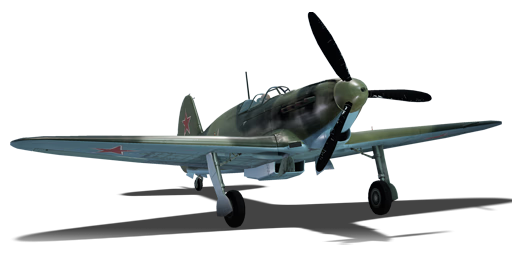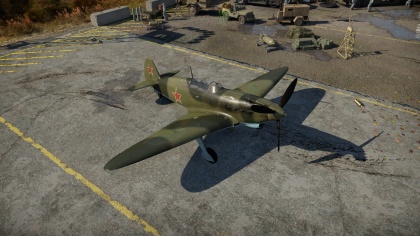Difference between revisions of "Yak-7B"
(Updated) |
(→History) |
||
| Line 221: | Line 221: | ||
== History == | == History == | ||
<!-- ''Describe the history of the creation and combat usage of the aircraft in more detail than in the introduction. If the historical reference turns out to be too big, take it to a separate article, taking a link to the article about the vehicle and adding a block "/ History" (example: <nowiki>https://wiki.warthunder.com/(Vehicle-name)/History</nowiki>) and add a link to it here using the <code>main</code> template. Be sure to reference text and sources by using <code><nowiki><ref></nowiki></code>, as well as adding them at the end of the article. This section may also include the vehicle's dev blog entry (if applicable) and the in-game encyclopedia description (under <code><nowiki>=== Encyclopedia Info ===</nowiki></code>, also if applicable).'' --> | <!-- ''Describe the history of the creation and combat usage of the aircraft in more detail than in the introduction. If the historical reference turns out to be too big, take it to a separate article, taking a link to the article about the vehicle and adding a block "/ History" (example: <nowiki>https://wiki.warthunder.com/(Vehicle-name)/History</nowiki>) and add a link to it here using the <code>main</code> template. Be sure to reference text and sources by using <code><nowiki><ref></nowiki></code>, as well as adding them at the end of the article. This section may also include the vehicle's dev blog entry (if applicable) and the in-game encyclopedia description (under <code><nowiki>=== Encyclopedia Info ===</nowiki></code>, also if applicable).'' --> | ||
| − | The Yakovlev Yak-7 was originally intended as a two-seat trainer version of the [[Yak-1]] fighter plane for the Soviet Air Force and only armed with 1 7.62 mm [[ShKAS (7.62 mm)|ShKAS]] MG for gunnery practice. Eventually, engineers at the Yakovlev Design Bureau modified the plane into a single-seat fighter superior to the Yak-1. The plane was armed with a single, propeller-mounted 20 mm [[ShVAK (20 mm)|ShVAK]] autocannon and 2 ShKAS machine guns in the engine cowling and included | + | |
| + | The Yakovlev Yak-7 was originally intended as a two-seat trainer version of the [[Yak-1]] fighter plane for the Soviet Air Force and only armed with 1 7.62 mm [[ShKAS (7.62 mm)|ShKAS]] MG for gunnery practice. Eventually, engineers at the Yakovlev Design Bureau modified the plane into a single-seat fighter superior to the Yak-1. The plane was armed with a single, propeller-mounted 20 mm [[ShVAK (20 mm)|ShVAK]] autocannon and 2 ShKAS machine guns in the engine cowling and included armour for the cockpit. The plane was quickly adopted by the air force and production was approved by late 1941. Unfortunately, Operation Barbarossa, the German invasion of the USSR had already begun and the relocation of factories to the Urals and more pressing needs elsewhere meant only 65 were available at the end of the year. Though it would see service as a fighter and interceptor, the aircraft was more often used as a fighter-bomber due to its ability to carry bombs and rockets for use against the Nazi and Italian ground forces. The Yak-7B would be introduced in 1942 and had a reduced wingspan, improved on-board systems, and an easier-to-produce undercarriage compared to the Yak-7A. Production of the Yak-7B would amount to over 5,000 aircraft produced. It would later see service with Albania, Bulgaria, Hungary, Mongolia, Poland, and Yugoslavia, which only received 2 Yak-7V planes. The [http://www.cheminsdememoire.gouv.fr/en/normandie-niemen-french-fighters-eastern-front Free French Air Force Normandie-Niemen squadron] would also employ the plane on the Eastern Front, eager to get revenge against the Luftwaffe that had bested them on the home front. | ||
| + | |||
| + | === In-game description === | ||
| + | |||
| + | "This Soviet single-engine fighter was based on the Yak-7UTI, a tandem-seat advanced trainer based on the Yak-1. The first Yak-7B rolled off the production line at Yakovlev in 1942; the last one was made in 1944. | ||
| + | |||
| + | The Yak-7B's armaments consisted of two 12.7 mm SHVAK machine guns and one 20 mm ShVAK cannon. In addition, bombs aboard the plane could be suspended. In all, the plane's manufacturer made more than 5,000 Yak-7Bs." | ||
== Media == | == Media == | ||
Revision as of 11:37, 9 May 2019
Contents
Description
The Yak-7B is a rank II Russian fighter
with a battle rating of 3.3 (AB) and 2.7 (RB/SB). This aircraft has been in the game since the start of the Open Beta Test prior to Update 1.29.
General info
Flight Performance
Describe how the aircraft behaves in the air. Speed, manoeuvrability, acceleration and allowable loads - these are the most important characteristics of the vehicle.
| Characteristics | |||||||
|---|---|---|---|---|---|---|---|
| Stock | |||||||
| Max Speed (km/h at ?,000 m) |
Max altitude (meters) |
Turn time (seconds) |
Rate of climb (meters/second) |
Take-off run (meters) | |||
| AB | RB | AB | RB | AB | RB | ||
| ? | ? | 9900 | ??.? | ??.? | ??.? | ??.? | ??? |
| Upgraded | |||||||
| Max Speed (km/h at ?,000 m) |
Max altitude (meters) |
Turn time (seconds) |
Rate of climb (meters/second) |
Take-off run (meters) | |||
| AB | RB | AB | RB | AB | RB | ||
| ? | ? | 9900 | ??.? | ??.? | ??.? | ??.? | ??? |
Details
| Features | ||||
|---|---|---|---|---|
| Combat flap | Take-off flap | Landing flap | Air brakes | Arrestor gear |
| X | X | ✓ | X | X |
| Limits | ||||
|---|---|---|---|---|
| Wing-break speed (km/h) |
Gear limit (km/h) |
Combat flap (km/h) |
Max Static G | |
| + | - | |||
| ??? | ~?? | ~? | ||
| Optimal velocities | |||
|---|---|---|---|
| Ailerons (km/h) |
Rudder (km/h) |
Elevators (km/h) |
Radiator (km/h) |
| < ??? | < ??? | < ??? | > ??? |
| Compressor (RB/SB) | ||
|---|---|---|
| Setting 1 | ||
| Optimal altitude | 100% Engine power | WEP Engine power |
| ?,??? m | ??? hp | ?,??? hp |
Survivability and armour
Examine the survivability of the aircraft. Note how vulnerable the structure is and how secure the pilot is, whether the fuel tanks are armoured, etc. Describe the armour, if there is any, and also mention the vulnerability of other critical aircraft systems.
Armaments
Offensive armament
The Yak-7B is armed with:
- 1 x 20 mm ShVAK cannon, nose-mounted (120 rpg)
- 2 x 12.7 mm Berezin UB machine guns, nose-mounted (260 rpg left + 140 rpg right = 400 total)
Suspended armament
The Yak-7B can be outfitted with the following ordnance:
- 2 x 50 kg FAB-50 bombs (100 kg total)
- 6 x RS-82 rockets
- 6 x RBS-82 rockets
Usage in battles
Describe the tactics of playing in an aircraft, the features of using vehicles in a team and advice on tactics. Refrain from creating a "guide" - do not impose a single point of view, but instead, give the reader food for thought. Examine the most dangerous enemies and give recommendations on fighting them. If necessary, note the specifics of the game in different modes (AB, RB, SB).
Manual Engine Control
| MEC elements | ||||||
|---|---|---|---|---|---|---|
| Mixer | Pitch | Radiator | Supercharger | Turbocharger | ||
| Oil | Water | Type | ||||
| ??? | ??? | ??? | ??? | ??? | ??? | ??? |
Modules
| Tier | Flight performance | Survivability | Weaponry | ||
|---|---|---|---|---|---|
| I | Fuselage repair | Radiator | Offensive 12 mm | BI-42 | |
| II | Compressor | Airframe | New 12 mm MGs | ||
| III | Wings repair | Engine | Offensive 20 mm | RO-82 | |
| IV | Cover | New 20 mm cannons | |||
Pros and cons
Pros:
- Hard-hitting cannon
- Good speed and maneuverability
- Low-caliber MGs are surprisingly effective thanks to high fire rate
- Great climb rate when spaded
Cons:
- Cannon has only 120 rounds of ammunition
- Sub-par performance when stock level aircraft
- Like most Soviet planes, performance at high altitude leaves much to be wanted.
History
The Yakovlev Yak-7 was originally intended as a two-seat trainer version of the Yak-1 fighter plane for the Soviet Air Force and only armed with 1 7.62 mm ShKAS MG for gunnery practice. Eventually, engineers at the Yakovlev Design Bureau modified the plane into a single-seat fighter superior to the Yak-1. The plane was armed with a single, propeller-mounted 20 mm ShVAK autocannon and 2 ShKAS machine guns in the engine cowling and included armour for the cockpit. The plane was quickly adopted by the air force and production was approved by late 1941. Unfortunately, Operation Barbarossa, the German invasion of the USSR had already begun and the relocation of factories to the Urals and more pressing needs elsewhere meant only 65 were available at the end of the year. Though it would see service as a fighter and interceptor, the aircraft was more often used as a fighter-bomber due to its ability to carry bombs and rockets for use against the Nazi and Italian ground forces. The Yak-7B would be introduced in 1942 and had a reduced wingspan, improved on-board systems, and an easier-to-produce undercarriage compared to the Yak-7A. Production of the Yak-7B would amount to over 5,000 aircraft produced. It would later see service with Albania, Bulgaria, Hungary, Mongolia, Poland, and Yugoslavia, which only received 2 Yak-7V planes. The Free French Air Force Normandie-Niemen squadron would also employ the plane on the Eastern Front, eager to get revenge against the Luftwaffe that had bested them on the home front.
In-game description
"This Soviet single-engine fighter was based on the Yak-7UTI, a tandem-seat advanced trainer based on the Yak-1. The first Yak-7B rolled off the production line at Yakovlev in 1942; the last one was made in 1944.
The Yak-7B's armaments consisted of two 12.7 mm SHVAK machine guns and one 20 mm ShVAK cannon. In addition, bombs aboard the plane could be suspended. In all, the plane's manufacturer made more than 5,000 Yak-7Bs."
Media
See also
External links
- Chemins de Memoire - The "Normandie-Niemen", French fighters on the Eastern Front
- Military Factory - Yakovlev Yak-7
| USSR fighters | |
|---|---|
| I-15 | I-15 WR · I-15 M-22 · I-15 M-25 · I-15bis · Krasnolutsky's I-15bis |
| I-153 M-62 · Zhukovsky's I-153-M62 · I-153P | |
| I-16 | I-16 type 5 · I-16 type 10 · I-16 type 18 · I-16 type 24 · I-16 type 27 · I-16 type 28 · I-180S |
| I-29 | I-29 |
| I-185 | I-185 (M-71) · I-185 (M-82) |
| I-225 | I-225 |
| ITP | ITP (M-1) |
| MiG-3 | MiG-3-15 · MiG-3-15 (BK) · MiG-3-34 |
| LaGG | I-301 · LaGG-3-4 · LaGG-3-8 · LaGG-3-11 · LaGG-3-23 · LaGG-3-34 · LaGG-3-35 · LaGG-3-66 |
| La | La-5 · La-5F · La-5FN · La-7 · Dolgushin's La-7 · La-7B-20 · La-9 · La-11 |
| Yak-1/7 | Yak-1 · Yak-1B · Yak-7B |
| Yak-3 | Yak-3 · Eremin's Yak-3(e) · Yak-3P · Yak-3T · Yak-3U · Yak-3 (VK-107) |
| Yak-9 | Yak-9 · Yak-9B · Golovachev's Yak-9M · Yak-9T · Yak-9K · Yak-9U · Yak-9UT · Yak-9P |
| Other countries | ▂P-40E-1 · ▂P-47D-27 · ▂Hurricane Mk IIB · ▂Fw 190 D-9 · ▂Spitfire Mk IXc |
| P-39 | ▂P-39K-1 · ▂Pokryshkin's P-39N-0 · ▂P-39Q-15 |
| P-63 | ▂P-63A-5 · ▂P-63A-10 · ▂P-63C-5 |





